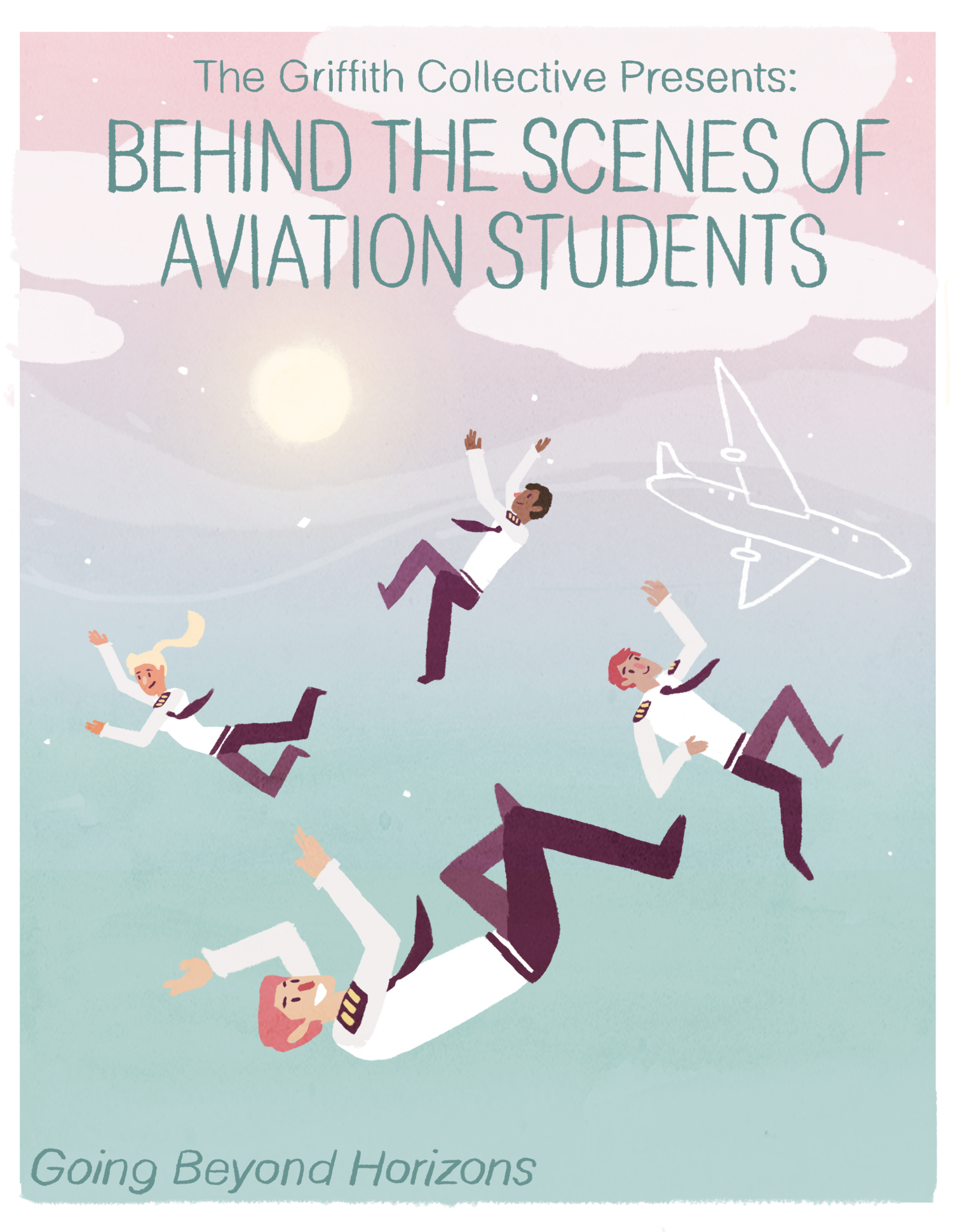How Aviation Students Are Going Beyond Horizons
Our social media reporter Hannah Sbeghen, goes behind the scenes to uncover the real-life experiences of aviation students and their desire to become professional pilots.
Imagine being 8500 feet above the ground and trying to ensure the ton of metal that you’re sitting in doesn’t fall from the sky. For the record, that’s 2.5 kilometres closer to the moon than almost everyone else on Earth. And now that you’re aware of this fact, dozens more thoughts begin racing through your mind…
Did you complete your checklist correctly? Did you forget something? There are so many buttons and switches in this plane, did you miss one?
Then there’s the weather, which has been bothering you since you checked the forecast: mostly cloudy with light showers. You’re being pedantic. Breathe. Inhale. Exhale. That’s better. Now you’re gliding nonchalantly, feeling a sense of infinite freedom, following maps that link only runways. You remember what the trainer said before you took off: “I am not liable for you.” It seemed such a strange thing to say at the time, but now it resonates as more a handing over of the controls, of responsibility. This is flying and it’s all up to you. You have to let doubt and hesitation go. Trust your gut, because today you are the pilot.
If you are interested in studying Aviation come to Open Day at Nathan Sunday 9 August. You should check out the Aviation information session from 10:00 – 11:00am (N02 Cinema) and test yourself on the Flight simulators, which are available all day in Science 1 (N25), Room 1.28. Check out the program here – Open Day Guides
This was the type of scenario that third year Griffith aviation student, Farhiz Soni, went through last semester during his first solo flight. Alone in the air from Brisbane to Sydney, it was an experience he describes as the most frightening in his life, but also the most exhilarating.
“A few of us were hand-picked by the base manager to fly down to Basair’s Sydney headquarters in Bankstown,” says Farhiz. “The first two boys went as a pair, which is to say they were in separate aircraft but left at the same time. I had to fly down by myself.”
With certain checkpoints, or wavepoints, along the route, it’s important to note that Farhiz didn’t have recourse to GPS.
“It’s quite challenging and even a bit scary knowing where you need to be, how you’re going to be and if you’re in the right area at the right time,” he says. “You have to think about landing at certain aerodromes, refuelling and taking off again.
“I had a few scary moments out at Tamworth and Bankstown. The weather was a concern, but it was also my best experience of flying so far.”
As much as Farhiz loves having his head in the clouds, his feet are very much on the ground. The Griffith student is broadening his horizons by studying a Bachelor of Aviation.
“When it’s just you at the controls, it’s daunting because you are completely in command of what happens. But the minute you have everything under control, you can enjoy the view around you and there’s nothing like it. It’s freedom in its purest form … flying.”
Farhiz was just five when his passion for flying began to reveal itself, aided by his grandfather and, of all things, the act of jumping out of a tree.
“When I was small, my grandfather used to work in the Air Force as an aerospace engineer. My brother wanted to be an engineer and I wanted to be a pilot. That’s just the way it was.”
Farhiz was also fond of an enormous eucalyptus tree outside the family home, and one day decided to use it to test his limitations. With the help of his 10-year-old brother’s highly imaginative aero-engineering skills to construct a pair of wings out of branches and bark, Farhiz climbed the tree.
Readying himself for take-off, his brother offered enthusiastic support: “You can do it. You’ve got wings. All you have to do is jump.”
“I ended up breaking my arm,” admits Farhiz. “But that was also the moment I was certain I wanted to be a pilot.”
Why study aviation?
Farhiz’s story reminds us that the world is made for exploring. When it comes to aviation, Griffith University has been providing tertiary qualifications to the aviation industry for more than two decades.
Meanwhile, the demand for Australian pilots is growing. Boeing predicts the Asia-Pacific region will become the world’s largest travel market and so intends to triple its aircraft fleet by 2034. That means opportunities for thousands of commercial pilots graduating from Australian flying schools.
What is studying aviation like?
Ryan Eiteneuer is a first year aviation student. An aspiring pilot whose biggest dream was to work in the Australian Defence Force, he is currently focused on overcoming exam hurdles. Still, that doesn’t mean he’s doing it alone.
“The best part about this is sharing the same passion with a group of people who picture the same dream as you,” says Ryan.
“I knew I wanted to be in the pilot’s seat with the Australian Defence Force from a very young age.”
However, when medical reasons precluded this, Griffith University gave Ryan the next best option.
“I feel like I’m on the right path, studying aviation with Griffith, and one day I’ll be a commercial airline pilot,” he says.
What do aviation students get up to?
Every Wednesday, Ryan attends Aviation Mates, a networking workshop that inspires him.
“We are introduced to industry professionals and informed about industry updates. My favourite part is that we are taught tools of the trade, like radio communication, and that gives we first year students a heads-up about the exciting stuff we can look forward to in the course.”
Griffith is a worldwide leader in online learning for aviation and in delivering innovative student-centred programs recognised by industry. Aviation Mates is all part of it.
“We receive industry updates on events in commercial, general and military aviation,” says Ryan.
“Then someone will speak about a particular aviation subject they are interested in, or we will learn something predetermined by our flight leaders, like navigation exercises or practice flight aptitude tests.”
Ryan particularly enjoys the weekly presentation by distinguished members of the aviation community.
“We have had the chief pilots from Virgin Australia and Qantas, as well as an ex-RAAF pilot. People like that inspire us to pursue our dreams in aviation.”
All of which brings us back to Farhiz, who says there are times he feels like a fighter pilot, especially when he gets the chance to barrel roll his plane.
Here’s how it’s done.
“Basically, I had to pitch down to build up speed and then pitch up 15 degrees,” he says.
“Roll the aircraft to the left with back pressure on the stick. Once perpendicular with the ground, ease the stick forward to counteract gravity and produce lift, because we are inverted and otherwise the plane will just fly down.
“Then, after the roll is three-quarters complete, release forward pressure on the stick and complete the spin.”
Do you think you could handle it after those instructions? Or maybe they should come with a disclaimer that says: Do not try this at home.
Women in aviation
While men continue to dominate the aviation industry, more and more women are excited and inspired by the thought of a career in the field. This is particularly relevant at Griffith.
The first Australian woman to make her mark in commercial aviation was the legendary Nancy Bird Walton in the 1930s. When she was young, she had the same passion and enthusiasm for flight as students like Farhiz and Ryan today.
In an interview with journalist George Negus in 2004, Nancy said: “As a four-year-old, my mother told me I was climbing the fence, jumping off and calling myself an ‘eppyplane’ … I bought books on aeroplanes; I followed everything in the newspapers about aeroplanes.”
Royal Australian Navy helicopter pilot, Lieutenant Tammielee Moffat, has been flying since she was 16 and says that while women make up a small percentage in aviation, the percentage is growing.
“I really believe you can’t aspire to be something if you can’t see it,” she told the ABC in an interview.
“I didn’t really have any role models until I got to the fleet air arm. For me, that was pivotal. I could see somebody seeing what I wanted to do.”
Speaking with Griffith’s aviation students, and going behind the scenes of their degree, the attraction of aviation at Griffith is a powerful one. It inspires and fuels dreams.
There are challenges, of course. But remember, planes take off against the wind, not with it.







